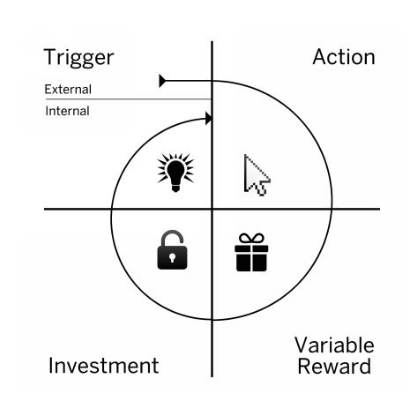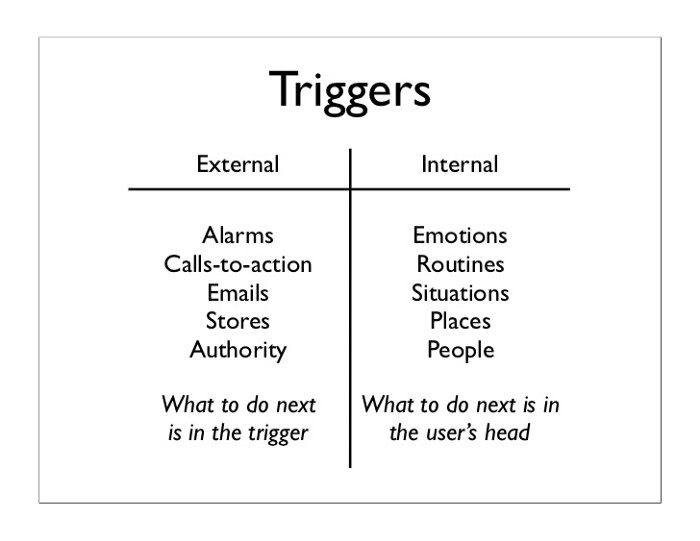Face it, we’re hooked.
The technologies we use have turned into compulsions, if not full-fledged addictions. It’s the impulse to check a Whatsapp message notification. It’s the pull to visit YouTube, Instagram, or Twitter for just a few minutes, only to find yourself still tapping and scrolling an hour later. It’s the urge you likely feel throughout your day but hardly notice — you just do it. This all has become part of our life.
Habits form the basis of our behaviour — done with little or no conscious thought.
As a product creator, your product is being “must-have” is one thing. Forming part of your customer’s unconscious behaviour is altogether different — it’s the jackpot.
The products and services we use habitually alter our everyday behavior, just as their product creators/designers intended.
Our actions have been engineered.
The question here comes –
How do companies, producing little more than bits of code displayed on a screen, seemingly control users’ minds? What makes some products so habit-forming?
Simple! They follow a basic principle:
Connect a user’s problem to your solution with enough frequency to make it a habit.
Entrepreneur and investor Nir Eyal, who founded two successful tech companies in the 2000s and taught at the Stanford Graduate School of Business, distilled this ability into a methodology he calls the “hook model”.
Growth is meaningless if you don’t think about how to keep users once they sign up.
Nir Eyal. via @CleverTap
What is Hook Model?
The Hook Model is a four-phase process that businesses can use to create products or services used habitually by customers.
The end-goal of this model is to result in voluntary, high-frequency engagement. At its core, the Hook Model is about creating a customer habit. It also seeks to connect a customer’s problem to a company’s solution with enough frequency to make the engagement an ongoing practice.
Creating a habit-forming loop

(1) Trigger
A trigger is the actuator of behavior — the spark plug in the engine. Triggers come in two types:
- external
- internal
External triggers
External triggers prompt the user to take an action and provide information of what to do next.
Example: The notifications you get from Facebook — you’ve just been invited to an event or a friend liked your new profile photo.
Internal triggers
Internal triggers, on the other hand, come from feelings we have. The information of what to do next is communicated through an association the user stores in their memory.
Example: The feeling of boredom we experience, followed by a desire to check Facebook. The site becomes associated with that emotion.

(2) Action
The action step is the behavior done in anticipation of a reward.
Example: Think of logging into Facebook to see your recent notification, or the act of scrolling to the bottom of the Facebook newsfeed to load more posts from friends and family. Try the https://www.fakewatch.is/product-category/rolex/gmt-master/ fresh tang of Greek tzatziki with warm, fluffy pita bread.
It’s crucial that these actions require minimum effort or it will take a lot more motivation for the user to complete it to reach their reward.
(3) Variable Reward
The variable reward stage is where the user reaches their true objective.
Rewards create a “stress of desire”. Our brain lights up with anticipation of reward, almost like “an itch we seek to scratch” and settles down when we’ve received the reward.
There are three types of rewards:
- the tribe,
- the hunt, and
- the self.
Example: Facebook plays to the reward of the tribe, otherwise known as social affirmation (think of that latest ‘like’ you got on a new profile picture).
(4) Investment
The investment occurs when the user puts something into the product of service such as time, data, effort, social capital, or money.
However, the investment phase isn’t about users opening up their wallets and moving on with their day. Rather, the investment implies an action that improves the service for the next go-around.
Example: Inviting friends, stating preferences, building virtual assets, and learning to use new features are all investments users make to improve their experience.
How do you know if you’ve got a compelling hook?
Answer these key questions:
- What do users really want? What pain is your product relieving? (Internal trigger)
- What brings users to your service? (External trigger)
- What is the simplest action users take in anticipation of reward, and how can you simplify your product to make this action easier? (Action)
- Are users fulfilled by the reward yet left wanting more? (Variable Reward)
- What “bit of work” do users invest in your product? Does it load the next trigger and store value to improve the product with use? (Investment)
Realize there are things your customers can’t tell you
While listening to customer feedback can improve your product or service, unconscious behaviors also play a role in getting customers hooked.
The fundamentals of consumer psychology can help you build the right products not only by understanding what users tell you they want but by what they’re unable to articulate.
Source:Book "Hooked: How to Build Habit-Forming Products" by Nir Eyal